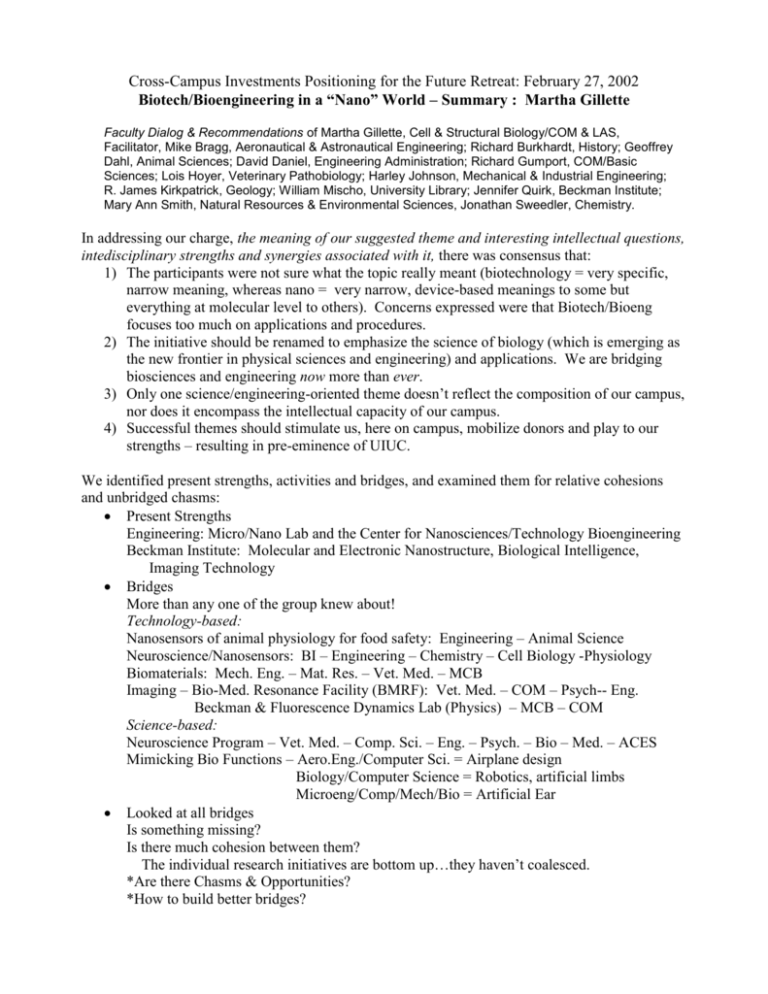Nano_World.Gillette.Summary - The University of Illinois Archives
advertisement

Cross-Campus Investments Positioning for the Future Retreat: February 27, 2002 Biotech/Bioengineering in a “Nano” World – Summary : Martha Gillette Faculty Dialog & Recommendations of Martha Gillette, Cell & Structural Biology/COM & LAS, Facilitator, Mike Bragg, Aeronautical & Astronautical Engineering; Richard Burkhardt, History; Geoffrey Dahl, Animal Sciences; David Daniel, Engineering Administration; Richard Gumport, COM/Basic Sciences; Lois Hoyer, Veterinary Pathobiology; Harley Johnson, Mechanical & Industrial Engineering; R. James Kirkpatrick, Geology; William Mischo, University Library; Jennifer Quirk, Beckman Institute; Mary Ann Smith, Natural Resources & Environmental Sciences, Jonathan Sweedler, Chemistry. In addressing our charge, the meaning of our suggested theme and interesting intellectual questions, intedisciplinary strengths and synergies associated with it, there was consensus that: 1) The participants were not sure what the topic really meant (biotechnology = very specific, narrow meaning, whereas nano = very narrow, device-based meanings to some but everything at molecular level to others). Concerns expressed were that Biotech/Bioeng focuses too much on applications and procedures. 2) The initiative should be renamed to emphasize the science of biology (which is emerging as the new frontier in physical sciences and engineering) and applications. We are bridging biosciences and engineering now more than ever. 3) Only one science/engineering-oriented theme doesn’t reflect the composition of our campus, nor does it encompass the intellectual capacity of our campus. 4) Successful themes should stimulate us, here on campus, mobilize donors and play to our strengths – resulting in pre-eminence of UIUC. We identified present strengths, activities and bridges, and examined them for relative cohesions and unbridged chasms: Present Strengths Engineering: Micro/Nano Lab and the Center for Nanosciences/Technology Bioengineering Beckman Institute: Molecular and Electronic Nanostructure, Biological Intelligence, Imaging Technology Bridges More than any one of the group knew about! Technology-based: Nanosensors of animal physiology for food safety: Engineering – Animal Science Neuroscience/Nanosensors: BI – Engineering – Chemistry – Cell Biology -Physiology Biomaterials: Mech. Eng. – Mat. Res. – Vet. Med. – MCB Imaging – Bio-Med. Resonance Facility (BMRF): Vet. Med. – COM – Psych-- Eng. Beckman & Fluorescence Dynamics Lab (Physics) – MCB – COM Science-based: Neuroscience Program – Vet. Med. – Comp. Sci. – Eng. – Psych. – Bio – Med. – ACES Mimicking Bio Functions – Aero.Eng./Computer Sci. = Airplane design Biology/Computer Science = Robotics, artificial limbs Microeng/Comp/Mech/Bio = Artificial Ear Looked at all bridges Is something missing? Is there much cohesion between them? The individual research initiatives are bottom up…they haven’t coalesced. *Are there Chasms & Opportunities? *How to build better bridges? Cross-cutting Initiatives Summary – Gillette February 27, 2002 How, in fact, do you make these groups work together? What are the justifications? What are potential outcomes? Identify/tackle problems too big for small groups Identify/develop graduate programs/recruitment thrusts that distinguish UIUC Attract funding/better deploy resources (prevent duplicate requests) Identify and bridge chasms e.g., Computational Initiatives exist at many sites across campus (Eng, Chem, Bio, NCSA), but they are not interactive Mimicking Biologic Functions for Eng. Applications – not developed well Recommendations for science/engineering-based themes Bioscience theme should have a NAME that better describes our strengths and directions: - Biology in a Modern World - New Discoveries in a Bio/Nano-World - Science and Technology in a Biological World (none quite right, as we recognized the need for spin and breadth) Sub-Bioscience themes that would make us the world’s pre-eminent institution (Note: We recongized that these are application-based. Science based subthemes take longer to develop, but some of the participants are interested in developing them.) Imaging: BioMedical - Security - Molecular/Interventional Biotechnology: for sustainable, affordable, environ-friendly bio-based economy - Plants – Biomass – Micorg – Energy --Novel products) Biosensors/Nanosensors: - Food product monitoring & safegy - Decreasing industrial waste - Biomedical devices - Security - Environmental toxicology Bioinformatics Important to expand the original 4 themes to areas of strength not emcompassed in this modified original theme. Two additional areas of strength and synergy were identified: 1. Truly tiny things – Nanostructures that interact with Macro World (Mol. Engineering and science) Because time was of the essence at this point, we left this for further development thru future discussions. 2. Information Technology (IT) in a Connected World Strengths: - IT = true strength of campus/but eroding - component of every item discussed - cuts across all disciplines (SCIENCE/ENG – HUMANITIES) - continued high potential for true impact Cross-cutting Initiatives Summary – Gillette February 27, 2002 Goal: UIUC = The World Leader in IT – on a global scale Chasms/New Nodes for Development: Bridging: Business, Library, Siebel Center, NCSA, ECE and everywhere on campus How to strengthen bridges? Develop solutions that transcend/address societal problems Strengthen HUMAN/TECHNOLOGY INTERFACE = Seamless, ubiquitous, human-centered Impact Education, Corporate, Industry (clearly distinguishable from “American Institutions”, but in liaison with that theme.) And Finally, there was a recognition that, overall, we need to keep our eye on the broad ethical issues.







